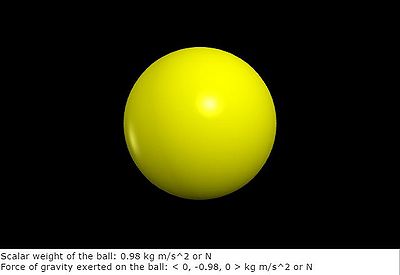Weight
Claimed by mxu86 (Michael Xu)
A page about weight as a property of matter.
The Main Idea
In physics, weight describes the Gravitational Force upon a mass, usually relative to Earth or a planet. Depending on the textbook, weight may be defined as a scalar - the magnitude of the gravitational force on an object - or a vector equal to gravitational force. An object's weight is commonly confused with mass, but instead it is a force that depends on another body of matter, while mass is an intrinsic property of matter.
A Mathematical Model
A mass m's weight near the surface of the Earth is represented by [math]\displaystyle{ {\vec{W} = \vec{F}_{g} = {m}\vec{g}} }[/math] where g is the gravitation acceleration of Earth, [math]\displaystyle{ {{\lt 0,-9.8,0\gt } \frac{m}{{s}^{2}}} }[/math].
Scalar weight would simply be the magnitude of the gravitational force, [math]\displaystyle{ {\left\vert{\vec{W}}\right\vert = \left\vert{\vec{F}_{g}}\right\vert} }[/math], and it can be simplified to [math]\displaystyle{ {\left\vert{\vec{W}}\right\vert = mg} }[/math].
A Computational Model
A simple segment of code that calculates the both scalar and vector weight (gravitational force) exerted upon a ball.

# Initializing sphere object
ball=sphere(pos=vec(0,0,0), radius=0.02, color=color.yellow, make_trail=true)
# Defining constants
g = vec(0,-9.8,0) #gravitational acceleration
ball.m=0.1 #mass of the ball in kg
W = ball.m*g #weight of the ball on Earth
# Printing values
print("Scalar weight of the ball:", mag(W), "kg m/s^2 or N")
print("Force of gravity exerted on the ball:", W, "kg m/s^2 or N")
Examples
Be sure to show all steps in your solution and include diagrams whenever possible
Simple
Determine the weight in Newtons of a 55 kilogram barbell on the surface of Mars, given the gravitational acceleration [math]\displaystyle{ {g}_{Mars} = 3.75\frac{m}{{s}^{2}} }[/math].
- [math]\displaystyle{ \left\vert{\vec{W}}\right\vert = m{g}_{Mars} }[/math]
- [math]\displaystyle{ \left\vert{\vec{W}}\right\vert = 55kg*3.75\frac{m}{{s}^{2}} }[/math]
- [math]\displaystyle{ \left\vert{\vec{W}}\right\vert = 206.25 N }[/math]
Connectedness
- How is this topic connected to something that you are interested in?
- Since most or all of my future work in engineering will be on planet Earth, future calculations and research may revolve around weight, mass, and other properties of matter. In addition, weight as well as weightlessness and space intrigue me, and I intend to do work in materials science that relates to space exploration.
- How is it connected to your major?
- Materials science involves engineering, physics, and chemistry, so understanding the intrinsic properties of matter is crucial to eventually manipulating and creating new combinations of materials.
- Is there an interesting industrial application?
- Weight
History
Since weight is essentially the force of gravitation, refer to Gravitational Force for more about the history of the Law of Gravitation.
See also
Gravitational Potential Energy
Further reading
Chabay & Sherwood: Matters and Interactions -- Modern Mechanics Volume 1, 4th Edition
External links
Physics Classroom lessons and notes
References
1. "Weight." Wikipedia. Wikimedia Foundation. Web. 1 Dec. 2015. <https://en.wikipedia.org/wiki/Weight#Gravitational_definition>.
2. "Types of Forces." Types of Forces. Physics Classroom. Web. 1 Dec. 2015. <http://www.physicsclassroom.com/class/newtlaws/Lesson-2/Types-of-Forces>.
3. "The Value of G." The Value of G. Physics Classroom. Web. 1 Dec. 2015. <http://www.physicsclassroom.com/class/circles/Lesson-3/The-Value-of-g>.